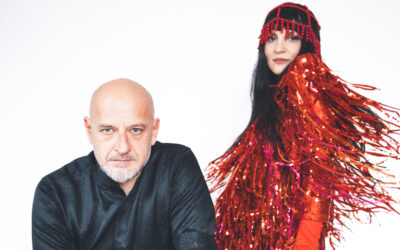All of the semi-finalists for this year’s Eurovision Song Contest have now rehearsed for the first time, and esc-chat.com has been keeping you up-to-date with live daily rehearsal blogs from Danny, our man on the scene in Copenhagen. But those of us who aren’t in Denmark are also following proceedings closely via the reports emerging from the press centre and the videos and photos published by eurovision.tv and various media sources. So we brought the other members of our editorial team – Felix from Germany, Shi from the USA/Israel and Martin from the United Kingdom – together to have a bit of a chat about their impressions so far!
Martin: Let’s start with some general thoughts. The venue and the stage, for example. I think it’s fair to say that the B&W Hallerne is, if not a massive venue, then certainly a tall one – and the Danes have reflected that in a visually imposing stage. But it’s a stage that risks making some of the performers look like tiny ants, especially in the long shots. Even hot favourites like Armenia looked a little bit lost in the middle of it all, although that might be more of a problem for the public in the arena than the TV viewers at home.
Shi: I think the stage is always a very tricky factor. It’s hard to tell how much impact it has on the result of a song. I do think some songs suffered in the past from the stage design, but without it a problem that necessarily applied to all songs on that stage. I was relieved to see that the Danes have entertained some restraint in how much they use the stage and aren’t trying to spend every minute showing all the things the stage can do at once. They seem to remember the stage serves as a backdrop and not as the star of the show.
Speaking of backdrops, the first round of rehearsals is always fun for discovering the look and feel of all the songs. I found the backdrop for Malta especially engaging as it is colorful and creates a warm and happy environment which adds to a pleasant song, which is not a bad way to open semi 2.

Malta in a warm and happy environment. © Andres Putting (EBU)
Felix: I agree that a stage can have a strong impact on an entry. It’s a material that every delegation has to work with, and year after year, the stage sets the creative borders for a performance. Unlike the stage feeling very wide and open like in other years (1988, 1993, 2009), this year the stage feels more enclosed, even though it’s surely bigger than the stage back in Dublin 1988. I’m afraid the box could come across as a cage or a prison, but this will fully depend on the camera shots that we have yet to see. Shi just talked about Malta, one of the entries that creatively works with the stage. The Maltese use the stage as an artistic tool by projecting photos onto the “Smart Glass” in the boxes. This technology allows you to switch transparency on or off with electricity, so it can be used for projections when it’s set to opaque.
Martin: Yes, Malta certainly stood out in that respect, and so far I’d say that Azerbaijan and Poland also seem to be effectively incorporating the stage into their artistic framing. The latter in particular are making good use of everything, from the backdrop right down to the water in the “moat” surrounding the performance area! Of course, when we talk about the stage it’s important for us – and all other fans sitting at home – to remember that the videos and photos we’re seeing are taken from a static position, so we still don’t know how things will look on camera. It could be that a lot of the entries seem more “intimate” through the lens. And we aren’t even seeing the floor of the stage in most of the videos and photos, which is certainly very different to how it will be on TV – take the Netherlands, for example, where we know that the floor will depict a road with the centre line running right between Ilse and Waylon. That’s an image I can imagine being hugely effective on screen, and very complementary to the style and mood of the Dutch song. Still, if you can’t make the stage work for you visually, there is an obvious solution and that’s to bring some props and gimmicks with you. And we’ve certainly seen plenty of those in the first three days.
Shi: Props and gimmicks always pose the 59-million dollar question: when do you need them? There’s nothing that annoys me more than a huge gimmick that has nothing to do with the song, but that is added anyway just for the sake of having one. Most of the major gimmicks this year come from the usual suspects, and some work better than others.
It’s easy for people to make fun of Russia’s see-saw, but I think that using the idea of symmetry in an entry sung by twins is sensible, even if not very original. Unlike Jedward, the Tolmachevy sisters are not likely to go crazy on stage so they needed something simple. Having a see-saw enables a rather clever play of getting in and out of symmetry. Azerbaijan, in a year in which they send their most difficult song to date, has surprised me by keeping it relatively low-key, but you can always trust them to think of something no one else is doing, and somehow having the woman on the trapeze actually suits the performance and the song. Then you have Ukraine, probably the record holder when it comes to using gimmicks that aren’t necessarily connected to the song in any way – and this year they have an hamster wheel! I get the idea of its movement (like a clock) and it seems to play off the backdrop, but I suspect it will also be a very difficult element for camerawork.

A Ukrainian hamster wheel. © Thomas Hanses (EBU)
On the other hand, there are some very literal gimmicks that are not necessarily a good idea. Georgia have matched the WTF effect of hearing their entry with a WTF effect of watching it, because that skydiver on stage really doesn’t help this look any saner. And Greece have brought a trampoline that is used by an Armenian gymnast to rise up towards the ceiling while somersaulting. Talk about tricky camerawork. It feels as if the director was determined to have a gimmick – any gimmick – but didn’t quite develop it. The winner of the kitchen-sink-throwing title so far is Romania, though, which really is trying everything in their entry, from holograms to an orbit-shaped-glowing-in-the-dark-while-being-played piano. It’s gimmicky enough to put them at risk of people forgetting to notice how crappy the song is. And don’t get me started about the choreographies.
Martin: Yes, and choreography leads me to one of the biggest “losers” of the first rehearsals, which is Ireland: it doesn’t matter how well they film this entry, those traditional dancers are doing some weird moves in the background and don’t even seem particularly skilled at what they’re doing. It’s just distracting. While we didn’t see it on camera, apparently Pollapönk from Iceland will form the word “LOVE” with their bodies at the end of the song, so they’re obviously happy enough to embrace the novelty side of their entry. And combining gimmicks with choreography, why on earth have Montenegro brought a roller-skater with them? Again, it does nothing but distract from the song, not to mention people will instantly think of Dima Bilan’s winning performance in 2008.

Montenegro in training for the Olympics. © Andres Putting (EBU)
Effective choreography has its place, though: Hungary is still playing out the domestic abuse scene in interpretive dance form, which could be troubling for some viewers but is certainly visually impressive; the flag-wavers from Portugal are ridiculous and cheesy but entirely in keeping with the fun vibe of the song; and Mei Finegold from Israel and her dancers engage in an awesome Beyoncé strut at one point – there are also some potentially awkward, Selma-esque moments where they writhe around on the floor, but I want to see how they look on camera before judging them. And let’s not forget the Slavic girls from Poland shaking their assets – what else would they be doing?
Felix: Also, just as in the preview video, Poland is not going to show too little skin – we can say this for sure even if the clothes worn at the rehearsals aren’t necessarily the ones worn on the night(s)! This probably applies for every entrant, with only the aforementioned Icelanders plus Tinkara from Slovenia and Kasey from Ireland seeming to have definitely had their actual show dresses on. Which makes me wonder why artists would want to wear dresses that match the colour of the backdrop. We saw with San Marino last year that wearing red in front of red doesn’t really do an entry any favours. Tinkara seems to wear blue in front of blue (at least in parts of the song), so will she have a similar result? It’s also still not known yet if we will see any fewer clothes: unlike the Irish dancers last year, no entry has featured shirtless guys in the rehearsals up to this point.

Slovenia play a game of “Spot The Singer”. © Sander Hesterman (EBU)
Shi: I hated the Irish dancers last year and thought it looked incredibly tacky. And it wasn’t helped by sounding bad too. When it comes to vocals, it’s not a huge leap to say that perfect vocals are always helpful. But an entry can be as likely to do well with so-so vocals as it is likely to go nowhere with a pitch-perfect performance, because so much depends also on the song and the staging. Vocals are also the hardest thing to judge in the early rehearsals, as the technical rehearsals focus on getting the stage and the camerawork right. Not all singers use the opportunity for a full vocal rehearsal, and some prefer to save their voices for later in the week. However, while we have a good idea about the vocal abilities of most artists, even the early rehearsals can answer some other open questions.
Sweden made a seamless transition from recorded backing vocals to live ones. Dilara from Azerbaijan gave a bad performance at Eurovision in Concert but has had no issues in Copenhagen so far. Russia is still tricky at this point, but between two lead singers and strong backing vocals, it doesn’t sound like the car crash I thought it might be. The vocals of Mei from Israel were a mystery for most of the season, but she has been very impressive – even if imperfect – even in the short video segment. Romania was shouty, which is similar to their NF performance. I thought it was bad sound in the hall, but it turns out it might just be the song. One thing I do think is important, even if you are not the world’s greatest vocalist, is to sell the hell out of your song. For me, the two losers of the first round of rehearsals are Ireland and FYR Macedonia as both girls sound scared, uncomfortable or both with their songs. There’s still time to work on this, but I suspect at least one of those is already doomed.
Martin: But even as full rehearsal clips show up in the next few days, it’s worth remembering how far this could still be from what we actually see on screen – or even hear, as the broadcast mix is very different from what you hear in the hall. Plus we’ve been misled by seemingly poor first rehearsals in the past – Chanée and N’evergreen are just one notable example where the press centre was screaming “shock non-qualifier” only for things to turn out rather differently! One thing is for sure, anyway: even if we won’t have reached the dress rehearsal stage yet, we’ll all know a lot more by the end of Saturday night.

Ireland: Still time to turn it around. © Sander Hesterman (EBU)
And that’s where we leave our review of the first impressions from the rehearsals in Copenhagen! Friday and Saturday will see the second batch of rehearsals, with 20 minutes allocated to each delegation to work on the problems we’ve identified above or, in some cases, build on the strong foundations they’ve already laid. Danny will be there to report live for you, so don’t forget to stay tuned to esc-chat.com for all the very latest!








0 Comments